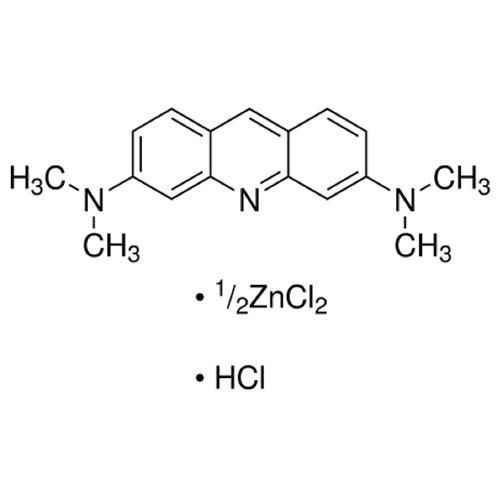Chemical, Cell culture, Cell staining, Cell staining
Acridine orange
- Catalog Number : C3318
- Number : C3318-5g
-
Size:
Qty : - Price : Request Inquiry
Introduction
Biochemical research. Used as a fluorescent indicator, a mutagen for tumor cells and bacteria, nucleic acid stains and frameshift mutations.
Acridine orange is a fluorescent pigment, and the acridine orange excitation filter has a wavelength of 488nm. The blocking filter has a wavelength of 515nm. Acridine orange has a difference in the amount of DNA and RNA binding in cells, and it can emit different colors of fluorescence (that is, coloring specificity). This is because DNA is a high polymer and has fewer positions for absorbing fluorescent substances and emits green fluorescence, while RNA The degree of polymerization is low, and there are many positions that can be combined with fluorescent substances, so it emits red fluorescence.
It can be embedded between two adjacent base pairs to loosen part of the double helix DNA and double the distance between the two base pairs. During such a DNA replication process, one base will be added or deleted in the DNA chain, causing frameshift mutations.
Acridine orange is a fluorescent pigment, and the acridine orange excitation filter has a wavelength of 488nm. The blocking filter has a wavelength of 515nm. Acridine orange has a difference in the amount of DNA and RNA binding in cells, and it can emit different colors of fluorescence (that is, coloring specificity). This is because DNA is a high polymer and has fewer positions for absorbing fluorescent substances and emits green fluorescence, while RNA The degree of polymerization is low, and there are many positions that can be combined with fluorescent substances, so it emits red fluorescence.
It can be embedded between two adjacent base pairs to loosen part of the double helix DNA and double the distance between the two base pairs. During such a DNA replication process, one base will be added or deleted in the DNA chain, causing frameshift mutations.
General Information
| Application | FCM, Cell, FC |
|---|---|
| Cas No. | 10127-02-3 |
| Purity | ≥80.0% |
| Molecular Weight | 369.96 |
| Formula | C17H20ClN3·0.5ZnCl2·HCl |
| Solubility | Soluble in water and ethanol, it is orange-yellow with green fluorescence. When encountering concentrated sulfuric acid, it is colorless with green fluorescence, and it is orange-yellow after dilution. The addition of sodium hydroxide to the aqueous solution produces a yellow precipitate . |
| Alias | Basic orange 3RN ; Rhoduline orange ; Euchrysine 3RXA ; C.I.46005 |
| Grade |
Electrophoresis Grade |
|---|
| pH(1% solution) |
6.5, pH value is 8.4~10.4, there is no fluorescence. |
|---|
| Apperance |
Orange-red to brown powder |
|---|







.png)